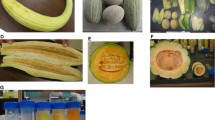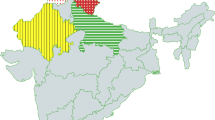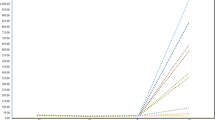Abstract
Fruit quality traits were studied in 12 exotic accessions and their hybrids with a “Piel de Sapo” inodorus melon cultivar. The genetic relationships among these genotypes were assessed with 16 microsatellite markers, which agreed with the classification of Cucumis callosus, C. pubescens and C. trigonus as accessions within C. melo. There were very large differences between all the exotic accessions and “Piel de Sapo” genotype for fruit traits. When the hybrids were analysed, three different situations regarding mid parent heterosis were found, depending on the trait: no heterosis (soluble solid concentration), highly variable, from negative to positive (fruit weight and fruit diameter) and general positive heterosis (ovary shape, fruit length and fruit shape). Best parent heterosis for fruit shape was also common among hybrids. A highly significant correlation (r = 0.81) was detected between fruit shape and fruit length heterosis, suggesting that fruit shape heterosis is caused mainly by the enlargement of the fruit longitudinally. A highly significant correlation (r = 0.84) between heterosis for fruit shape and genetic distance, as estimated with microsatellites, was also found. These results, together with the previously reported observation that melon fruit shape is polygenic and highly heritable, makes the genetics of melon fruit shape a suitable system for dissecting the genetic and molecular basis of heterosis.
Similar content being viewed by others
Abbreviations
- HMP:
-
mid parent heterosis
- HBP:
-
best parent heterosis
- OS:
-
ovary shape
- FW:
-
fruit weight
- FD:
-
fruit diameter
- FL:
-
fruit length
- FS:
-
fruit shape
- SSC:
-
soluble solid concentration
References
Abadia, J., M.L. Gomez-Guillamon, J. Cuartero & F. Nuez, 1985. Inheritance mode of melon fruit characters. Cucur Genet Coop Rep 8: 34–35.
Akashi, Y., N. Fukunda, T. Wako, M. Masuda & K. Kato, 2002. Genetic variation and phylogenetic relationships in East and South Asian melons, Cucumis melo L., based on the analysis of five isozymes. Euphytica 125: 385–396.
Ali, M., L.O. Copeland, S.G. Elias & J.D. Kelly, 1995. Relationship between genetic distance and heterosis for yield and morphological traits in winter canola (Brassica napus L.). Theor Appl Genet 91: 118–121.
Allard, R.W., 1996. Genetic basis of the evolution of adaptedness in plants. Euphytica 92: 1–11.
Bruce, A.B., 1910. The Mendelian theory of heredity and the augmentation of vigour. Science 32: 627–928.
Cerna, F.J., S.R. Cianzio, A. Rafalski, S. Tingey & D. Dyer, 1997. Relationship between seed yield heterosis and molecular marker heterozygosity in soybean. Theor Appl Genet 95: 460–467.
Chakravarthy, H.L., 1959. Monograph on Indian Cuccurbitaceae – Taxonomy and distribution. Rec Bot Surv India 17: 98–112.
Cheres, M.T., J.F. Miller, J.M. Crane & S.J. Knapp, 2000. Genetic distance as a predictor of heterosis and hybrid performance within and between heterotic groups in sunflower. Theor Appl Genet 100: 889–894.
Chowdari, K.V., S.R. Venkatachalam, A.P. Davierwala, V.S. Gupta, P.K. Ranjekar & O.P. Govila, 1998. Hybrid performance and genetic distance as revealed by the (GATA)4 microsatellite and RAPD markers in pearl millet. Theor Appl Genet 97: 163–169.
Danin-Poleg, Y., N. Reis, G. Tzuri & N. Katzir, 2001. Development and characterisation of microsatellite markers in Cucumis. Theor Appl Genet 102: 61–72.
Dunnet, C.W., 1955. A multiple comparison procedure for comparing several treatments with a control. J Am Stat Assoc 50: 1096–1121.
Eduardo, I., P. Arús & A.J. Monforte, 2003. Development of a collection of Near Isogenic Lines (NILs) in melon. In: Proceedings of the Seventh International Congress of Plant Molecular Biology, 23–28 June, Barcelona, Spain.
Garcia-Mas, J., M. Oliver, H. Gómez-Paniagua & M.C. De Vicente, 2000. Comparing AFLP, RAPD and RFLP markers for measuring genetic diversity in melon. Theor Appl Genet 101: 860–864.
Hua, J.P., Y. Sing, W. Wu, C. Xu, S. Sun, S. Yu & Q. Zhang, 2003. Single-locus heterotic effects and dominance by dominance interactions can adequately explain the genetic basis of heterosis in an elite rice hybrid. Proc Natl Acad USA 100: 2574–2579.
Hua, J.P., Y.Z. Xing, C.G. Xu, X.L. Sun, S.B. Yu & Q. Zhang, 2002. Genetic dissection of an elite rice hybrid revealed that heterozygotes are not always advantageous for performance. Genetics 162: 1885–1895.
Jeffrey, C., 1980. A review of the Cucurbitaceae. Bot J Linn Soc 81: 233–247.
Jordan, D.R., Y. Tao, I.D. Godwin, R.G. Henzell, M. Cooper & C.L. McIntyre, 2003. Prediction of hybrid performance in grain sorghum using RFLP markers. Theor Appl Genet 106: 559–567.
Kirkbride, J.H., 1993. Biosystematic Monograph of the Genus Cucumis (Cucurbitaceae). Parkway Publishers, North Caroline, USA.
Kitroongruang, N., W. Poo-Swang & S. Tokumasu, 1992. Evaluation of combining ability, heterosis and genetic variance for plant growth and fruit quality characteristics in Thai-melon (Cucumis melo L., var. acidulous Naud.). Sci Hortic 20: 79–87.
Kumar, S., K. Tamura, I.B. Jakobsen & M. Nei, 2001. MEGA2: Molecular evolutionary genetics analysis software. Bioinformatics 17: 1244–1245.
Li, Z.K., L.J. Luo, H.W. Mei, D.L. Wang, Q.Y. Shu, R. Tabien, D.B. Zhong, C.S. Ying, J.W. Stansel, G.S. Khush & A.H. Paterson, 2001. Overdominant epistatic loci are the primary genetic basis of inbreeding depression and heterosis in rice. I. Biomass and grain yield. Genetics 158: 1737–1753.
Li, Z.K., S.R.M. Pinson, W.D. Park, A.H. Paterson & J.W. Stansel, 1997. Epistasis for three grain yield components in rice (Oryza sativa L.). Genetics 145: 453–465.
Liu, J., J. Van Eck, B. Cong & S.D. Tanksley, 2002. A new class of regulatory genes underlying the cause of pear-shaped tomato fruit. Proc Natl Acad Sci USA 99: 13302–13306.
Lu, H., J. Romero-Severson & R. Bernardo, 2003. Genetic basis of heterosis explored by simple sequence repeat markers in a random-mated maize population. Theor Appl Genet 107: 494–502.
Manjarrez-Sandoval, P., T.E. Carter Jr., D.M. Webb & J.W. Burton, 1997. Heterosis in soybean and its prediction by genetic similarity measures. Crop Sci 37: 1443–1452.
Melchinger, A.E., H.F. Utz, C.C. Schon, 1998. Quantitative trait locus (QTL) mapping using different testers and independent population samples in maize reveals low power of QTL detection and large bias in estimates of QTL effects. Genetics 149: 383–403.
Monforte, A.J., M.J. Asíns & E.A. Carbonell, 1997. Salt tolerance in Lycopersicon species. VI. Genotype-by-salinity interaction in quantitative trait loci detection: Constitutive and response QTLs. Theor Appl Genet 95: 706–713.
Monforte, A.J., E. Fridman, D. Zamir & S.D. Tanksley, 2001. Comparison of a set of allelic QTL-NILs for chromosome 4 of tomato: Deductions about natural variation and implications for germplasm utilization. Theor Appl Genet 102: 572–590.
Monforte, A.J., J. Garcia-Mas & P. Arús, 2003. Cucumis melo L. intraspecific classification based on microsatellite variation. Plant Breed 122: 153–157.
Monforte, A.J., M. Oliver, M.J. Gonzalo, J.M. Alvarez, R. Dolcet-Sanjuan & P. Arús, 2004. Identification of quantitative trait loci involved in fruit quality traits in melon (Cucumis melo L.). Theor Appl Genet 108: 750–758.
Monforte, A.J. & S.D. Tanksley, 2000. Fine mapping of a quantitative trait locus (QTL) from Lycopersicon hirsutum chromosome 1 affecting fruit characteristics and agronomic traits: Breaking linkage among QTLs affecting different traits and dissection of heterosis for yield. Theor Appl Genet 100: 471–479.
Morales, M., M. Luis Arteaga, J.M. Álvarez, R. Dolcet-Sanjuan, A. Monfort, P. Arús & J. Garcia-Mas, 2002. Marker saturation of the region around the gene conferring resistance to the melon necrotic spot carmovirus (MNSV) in melon. J Am Soc Hortic Sci 127: 540–544.
Nei, M., 1972. Genetic distance between populations. Am Nat 106: 283–292.
Parthasarathy, V.A. & C.N. Sambandam, 1980. Taxonomy of Cucumis callosus (Rottl.) Cogn. – the wild melon of India. Cucur Genet Coop Rep 3: 66–67.
Périn, C., L.S. Hagen, N. Giovinazzo, D. Besombes, D. Dogimont & M. Pitrat, 2002. Genetic control of fruit shape acts prior to anthesis in melon (Cucumis melo L.). Mol Genet Genom 266: 933–941.
Pitrat, M. & H. Lecoq, 1980. Inheritance of resistance to cucumber mosaic virus transmission by Aphis gossypii in Cucumis melo. Phytopatology 70: 958–961.
Pitrat, M., P. Hanelt & K. Hammer, 2000. Some comments on infraspecific classification of cultivars of melon. Acta Hortic 510: 29–36.
Puchalski, J.T., R.W. Robinson & J.W. Shail, 1978. Comparative electrophoresis of isoenzymes of Cucumis species. Cucur Genet Coop Rep 1: 39.
Schull, G.H., 1908. The composition of a field maize. Am Breeders' Assoc Rep 4: 296–301.
Schultheis, J.R., W.R. Jester & N.J. Augostini, 2002. Screening melons for adaptability in North Carolina. In: J. Janick & A. Whipkey (Eds.), Trends in New Crops and New Uses, pp. 439–444. ASHS Press, Alexandria, VA.
Soria, D., A.I. López-Sese & M.L. Gómez-Guillamón, 1996. Resistance mechanisms of Cucumis melo var. agrestis against Trialeurodes vaporariorum and their use to control a clopterovirus that causes a yellowing disease of melon. Plant Pathol 45: 761–766.
Stepansky, A., I. Kovalski & R. Perl-Treves, 1999. Intraspecific classification of melons (Cucumis melo L.) in view of their phenotypic and molecular variation. Plant Syst Evol 217: 313–332.
Stuber, C.W., S.E. Lincoln, D.W. Wolff, T. Helentjaris & E.S. Lander, 1992. Identification of genetic factors contributing to heterosis in a hybrid from two elite maize inbred lines using molecular markers. Genetics 132: 823–839; Theor Appl Genet (1997) 95: 706–713.
Tanksley, S.D., 1993. Mapping polygenes. Ann Rev Genet 27: 205–233.
Tanksley, S.D. & S.R. McCouch, 1997. Seed banks and molecular maps: Unlocking genetic potential from the wild. Science 277: 1063–1066.
Van der Knaap, E., Z.B. Lippman, S.D. Tanksley, 2002. Extremely elongated tomato fruit controlled by four quantitative trait loci with epistatic interactions. Theor Appl Genet 104: 241–247.
Xiao, J.H., J.M. Li, L.P. Yuan & S.D. Tanksley, 1995. Dominance the major genetic basis of the heterosis in rice as revealed by QTL analysis using molecular markers. Genetics 140: 745–754.
Xiao, J., J. Li, L. Yuan, S.R. McCouch & S.D. Tanksley, 1996. Genetic diversity and its relationship to hybrid performance and heterosis in rice as revealed by PCR-based markers. Theor Appl Genet 92: 637–643.
Xiao, J., J. Li, S. Grandillo, S.N. Ahn, L. Yuan, S.D. Tanksley & S.R. McCouch, 1998. Identification of trait-improving quantitative trait loci alleles from a wild rice relative, Oryza rufipogon. Genetics 150: 899–909.
Yu, S.B., J.X. Li, Y.F. Tan, Y.J. Gao, X.H. Li, Q. Zhang & M.A. Saghai Maroof, 1997. Importance of epistasis as the genetic basis of heterosis in an elite rice hybrid. Proc Natl Acad Sci USA 94: 9226–9231.
Zhang, Q., Y.J. Gaco, S.H. Yang, R.A. Ragab, M.A. Saghai Maroof & Z.B. Li, 1994. A diallele analysis of heterosis in elite hybrid rice based on RFLPs and microsatellites. Theor Appl Genet 89: 185–192.
Zhihua, M., 1995. Heredity of main economic characteristics of the Cucumis melo. Acta Hortic 402: 66–71.
Author information
Authors and Affiliations
Corresponding author
Rights and permissions
About this article
Cite this article
José, M.A., Iban, E., Silvia, A. et al. Inheritance mode of fruit traits in melon: Heterosis for fruit shape and its correlation with genetic distance. Euphytica 144, 31–38 (2005). https://doi.org/10.1007/s10681-005-0201-y
Received:
Accepted:
Issue Date:
DOI: https://doi.org/10.1007/s10681-005-0201-y




